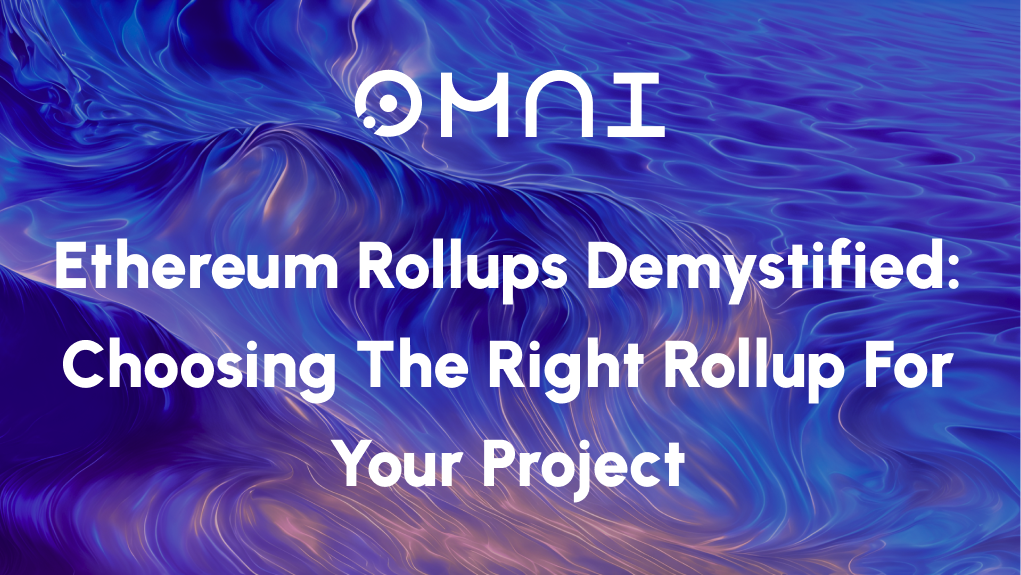Ethereum Rollups Demystified: Choosing the Right Rollup for Your Project
Ethereum Rollups: the game-changer in blockchain scalability. Dive into the essentials of rollups, compare Optimistic vs. ZK, and discover how Omni aggregates the divide for developers.

As the blockchain and crypto spaces evolve, navigating these realms can seem increasingly complex. A perfect example? Ethereum rollups. For developers aiming to enhance their project’s performance and security on the Ethereum network, understanding rollups is imperative. In this blog, we'll provide a comprehensive introduction to Ethereum rollups, analyze the major players in the rollup ecosystem, and delve into how the Omni platform can supercharge your project’s reach across these rollups.
Introduction to Ethereum Rollups: Why They’re Essential for Developers
The invention of Ethereum has revolutionized the internet, presenting the opportunity for developers to create autonomous and unstoppable software for people everywhere in the world. Yet, it hasn’t been all smooth sailing; challenges like scalability and rising transaction fees persist.
This is where Ethereum rollups come into play. The term "rollup" in the context of Ethereum refers to the method of "rolling up" many off-chain transactions into a single on-chain proof. These layer-2 solutions increase the transaction throughput, allowing the Ethereum blockchain to handle more operations efficiently. Rollups offer developers an introduction to Ethereum's advanced capabilities without the limitations. For developers, understanding rollups is paramount to leveraging the Ethereum network efficiently.
Why are Ethereum rollups vital? They offer:
- Faster transaction confirmation.
- Reduced transaction fees.
- Enhanced scalability without compromising security.
Overview of major rollups and their unique features
Ethereum rollups, by design, aggregate multiple off-chain transactions into one, subsequently committing specific data back to the main chain. This increases the throughput, presenting multiple operations as a single “event” on the Ethereum blockchain.
Key Highlights:
- EVM Compatibility: A version of the Ethereum Virtual Machine (EVM) runs within rollups, enabling seamless Ethereum transaction execution at a fraction of the cost.
- Scalability: Not infinite but significant, rollups boost scalability by compressing transaction data.
The Rollup Divide: Optimistic vs. ZK Rollups:
- Optimistic Rollups: They use a technique that assumes transactions are correct by default unless proven otherwise. It improves transaction speeds but has longer withdrawal periods.
- ZK Rollups: Leveraging zero-knowledge proofs, zkRollups offer high throughput rates and rapid withdrawals because when the batched transactions are posted to Ethereum they are posted with a mathematical proof of their validity. ZK rollups encompass a ZK-SNARK proof for batch validation, upholding privacy.
Comparisons:
- Cost: Optimistic rollups cut on-chain costs, while ZK rollups, despite lower data costs, have computational overheads due to ZK proof generation.
- Withdrawal delays: ZK rollups, with under 10-minute withdrawal times, outcompete optimistic rollups.
- Complexity: The secure operation of ZK rollups demands understanding ZK-SNARKs, whereas optimistic rollups rely on fraud-proof concepts.
Both rollup types shine in unique scenarios, and their adoption will cater to specific needs and developer inclinations. But with these plethoras of options and use cases, how does a developer decide the best fit for their project?
This is where Omni comes into play.
Omni as a platform: How Omni can help developers get the most out of all rollups for maximum reach
Choosing the right rollup solution may feel overwhelming. That's where Omni illuminates the path. Omni is an aggregation layer for all Ethereum rollups. It ensures that developers, instead of being restricted to a single rollup, can design applications that span the entire Ethereum ecosystem, accessing every user and capital across different rollups.
For those diving into the rollup Ethereum ecosystem, Omni offers:
- Interoperability with Ethereum's Security: Interoperability has been a vulnerability hotspot in DeFi. Omni's approach derives its security from Ethereum, eliminating the typical risks associated with interoperability. By integrating EigenLayer, Omni ensures swift and affordable communication between rollups with unmatched security.
- Programmable Interoperability: Omni's infrastructure offers not just robust security but also exceptional functionality. Its programmable interoperability layer means applications are global by default without complicating the developer’s journey. Such interoperability also bestows omnichain applications with distinct economic benefits, like multi-rollup liquidity aggregation.
- Extended Reach: Being on Omni, you don’t have to pick one rollup; you tap into the potential of all. Thus allowing you to cater for users scattered across all these rollups, removing the headache of bridging their assets over.
In essence, the Omni network empowers developers, ensuring their projects remain versatile, adapting seamlessly with diverse rollup Ethereum solutions and beyond.
Conclusion
In conclusion, Ethereum rollups are transforming the developer landscape. With the right tools and knowledge, thriving in the world of crypto is within reach. By choosing the right rollup, projects can witness unparalleled growth, and with platforms like Omni Network, the potential is limitless.
About Omni
The Omni Network is a layer 1 blockchain built to connect all rollups. Using Omni, developers can build global applications that are available across all rollups. Secured through restaking $ETH, Omni is a next-generation blockchain leading the frontier in both security and functionality.
Omni is backed by $18M from prominent investors such as Pantera Capital, Two Sigma Ventures and Jump Crypto.

